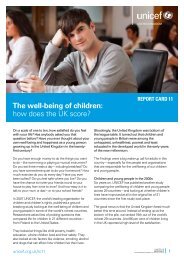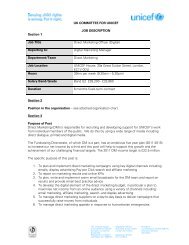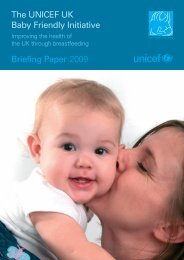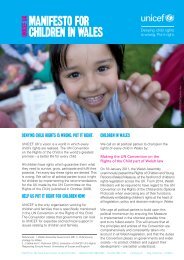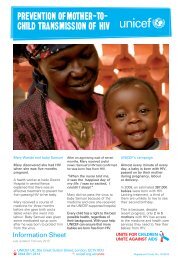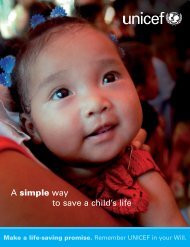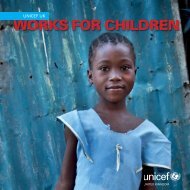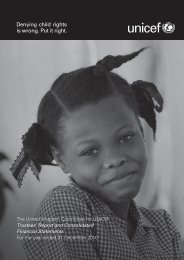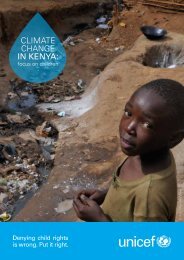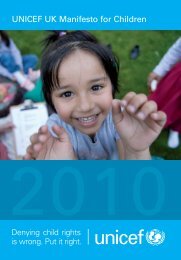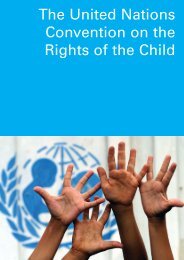The children left behind - Innocenti Research Centre
The children left behind - Innocenti Research Centre
The children left behind - Innocenti Research Centre
You also want an ePaper? Increase the reach of your titles
YUMPU automatically turns print PDFs into web optimized ePapers that Google loves.
2 0 I n n o c e n t i R e p o r t C a r d 9<br />
Action to prevent <strong>children</strong> from falling<br />
<strong>behind</strong> in different dimensions of wellbeing<br />
must therefore eventually come<br />
face to face with the question of the<br />
socio-economic gradient.<br />
Income poverty<br />
Socio-economic status is about more<br />
than income. A family’s past savings<br />
and future prospects, housing and<br />
neighbourhoods, levels of parental<br />
education and expectation, and status<br />
in relation to the mainstream or<br />
established ethnic or linguistic<br />
community – all of these enter into<br />
the socio-economic equation. Yet<br />
of the available measures, the most<br />
important single guide to, and<br />
predictor of, a family’s socio-economic<br />
status remains its level of household<br />
income. Reducing bottom-end<br />
inequality in incomes will not solve<br />
all other problems, but it will make<br />
their solution easier. Climbing the<br />
socio-economic ladder is more feasible<br />
if the rungs are closer together.<br />
Reviewing many studies that show<br />
a strong and consistent association<br />
between relative income poverty and<br />
‘falling <strong>behind</strong>’, Susan Mayer makes<br />
the point unflinchingly:<br />
Parental income is positively correlated<br />
with virtually every dimension of child<br />
well-being that social scientists measure,<br />
and this is true in every country for which<br />
we have data. <strong>The</strong> <strong>children</strong> of rich parents<br />
are healthier, better behaved, happier and<br />
better educated during their childhood and<br />
wealthier when they have grown up than<br />
are <strong>children</strong> from poor families. xxiii<br />
Relative income poverty therefore<br />
occupies a primus inter pares position<br />
among the indicators of ‘falling<br />
<strong>behind</strong>’. But monitoring of income<br />
poverty that can exert such leverage<br />
over the trajectories of <strong>children</strong>’s lives<br />
is not simply a matter of calculating<br />
what proportion of a nation’s <strong>children</strong><br />
is growing up in households whose<br />
income falls below a given threshold.<br />
<strong>The</strong> depth, duration and timing of that<br />
poverty in relation to the different<br />
stages of a child’s development may<br />
also be critical. A 2007 Canadian<br />
review of research into this issue<br />
refines the point:<br />
Studies that measure family income over<br />
extended periods of time and include<br />
changes in income and the depth of income<br />
inequality in their models and analysis<br />
Box 2 First call: <strong>children</strong> and recession<br />
<strong>The</strong> time lag between the gathering of data through<br />
sample surveys in different countries and the publishing<br />
of that data in internationally comparable form is<br />
approximately 3 years. Most of the data in this report<br />
therefore apply to the years 2006 to 2008.<br />
Normally, such a delay is no more than frustrating.<br />
Socio-economic data of a kind used here tend to reflect<br />
long-term trends rather than year on year changes.<br />
But much has changed in the world since 2008. Economic<br />
recession has affected millions in the OECD countries.<br />
<strong>The</strong> response of governments, whether by cuts in<br />
spending or increases in taxation, is affecting many<br />
millions more. Across the European Union, for example,<br />
unemployment is predicted to surpass the 10% mark by<br />
the time this report is published. This means that<br />
approximately 5 million more people will be unemployed<br />
than before the crisis began. As joblessness is a principal<br />
driver of poverty, it is likely that the material well-being of<br />
<strong>children</strong> has deteriorated in some countries since 2008.<br />
In the European Union, youth unemployment, in particular,<br />
has risen from a pre-crisis level of under 15% to more<br />
than 20% today. 1 Many households have seen their<br />
incomes fall and are facing difficulties with debt<br />
repayments. In the United States, as many as half of all<br />
workers have taken a cut in pay or hours or suffered at<br />
least temporary unemployment in the two half years since<br />
the crisis struck. 2 Migrant workers and those on short-term<br />
contracts are particularly vulnerable.<br />
<strong>The</strong>re may be worse to come. According to a report by<br />
the European Union Social Protection Committee “<strong>The</strong> full<br />
impact of the crisis on labour markets and public finances<br />
has yet to be faced.” 3<br />
In other words, the snapshot of inequality in <strong>children</strong>’s<br />
well-being presented in these pages is a snapshot taken<br />
in good times.<br />
No overall statistics are yet available to chart the impact<br />
of recession on the <strong>children</strong> of the poorest families. But a<br />
partial glimpse may be offered by the changing demands<br />
on charities and government special assistance<br />
programmes. <strong>The</strong> International Federation of Red Cross and<br />
Red Crescent Societies, for example, is reporting increasing<br />
numbers of people seeking help “with the basic necessities<br />
of life – including some who would never normally think of<br />
seeking help from a charitable body.” 4 In the United States,<br />
the number of people receiving SNAP benefits (under the<br />
Supplementary Nutritional Assistance Program) has risen<br />
by almost a quarter since the crisis began (from 29.5 million<br />
to 36.5 million people a month in the year to August 2009).<br />
Approximately half of all SNAP beneficiaries are <strong>children</strong>. 5<br />
It is also worrying that the Eurochild report is beginning to<br />
show increases in demands on child protection services<br />
in a number of European countries. 6



